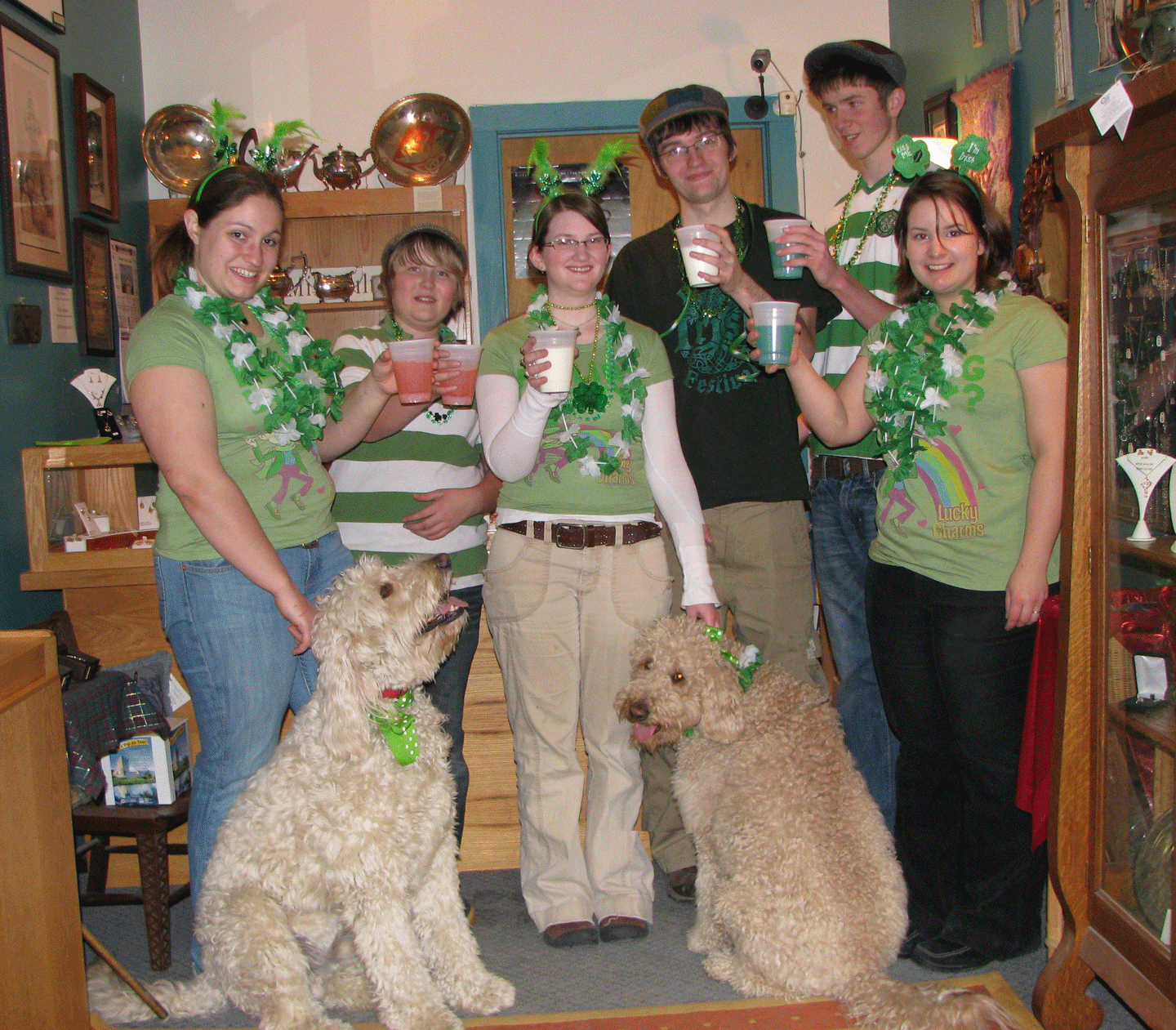- Jewelry
- Crosses
- Rings
- Mens
- Claddagh
- Wedding
- Personalized Jewelry
- John Urban Jewelry
- Sale
- Gift Certificates
- About Us

Many years ago my wife’s relatives organized a family reunion. The invitations were festooned with green clip-art shamrocks. Even though the gathering was a picnic in the summer, the party decorations had a sort of Saint Patrick’s Day theme. As a professional designer craftsman who specializes in Celtic art, I was disappointed with what I was perceiving as a kitschy portrayal of the American family’s Irish roots.
Let’s face it, much of the green-beer revelry and kiss-me-I’m-Irish plastic vulgarities that come out around the middle of March every year are hardly consistent with the sophistication of such great masterpieces of Celtic heritage as the Book of Kells or the Tara Brooch. This is the Celtic identity that I embraced.
In the late 1960s, when I first was exposed to the medieval tradition of interlaced and complex geometric abstractions that are known as Celtic art, it was special, rare and exotic. Those that I met who recognized and displayed Celtic art seemed to me to have more sophisticated expression of Irish heritage than the shamrock people. It was the same with Irish music. The popular toora-loora-loora songs and Vaudeville Irish ditties had become the stereotypes of the American Irish identity. I was far more impressed by traditionalist musicians such as The Chieftains.
Six years in art school had made me something of a snob. The shamrock motif seemed to me low brow. But there is obviously something to it. Maybe it was just overdone. My own use of interlaced designs, spirals and key patterns, though rarely encountered in mainstream culture before around 1990, have become far more common in recent years. The Celtic knot-work that was rare in modern decorative arts during my youth is now so mainstream that you will see it on the Saint Patrick’s Day tee shirts on sale at Walmart. So much for my highbrow Celtic motifs!
In modern Ireland, shamrocks are rarely encountered as a banner at someone’s home, as you so often see in America. Shamrocks in Ireland are usually facing the tourist’s gaze, quite likely pandering to the appetite for symbols of Irish identity sought out by the Irish-American tourists. Look a little deeper and you will see many surviving shamrocks on monuments and decorating antiques from the nineteenth and early twentieth centuries. This was the period of the largest emigration out of Ireland, and into America. Apparently, a century ago in Ireland, the shamrock was used in a popular way much more than today. As I realized this my prejudice against the shamrock as a kitsch began to lose confidence.
My adventures have taken me on frequent trips to Ireland where I have met and become friends with some excellent Celtic artists and craftsmen. Aidan Breen, a Dublin based silversmith, is held in high esteem by his countrymen. His reputation as one of the leading designer craftsmen working in the Celtic genre has landed his work in such high-status collections as the Company of Goldsmiths permanent exhibit at Dublin Castle and the National Museum of Ireland. Aidan Breen has made some exquisite shamrock themed jewelry. If shamrocks are good enough for him, why should I hold back?
Aidan told me, “It is a particular type that looks down on the Shamrock, probably because it’s popular with the majority of ordinary people. Everyone I know wears the Shamrock on Saint Patrick’s Day. It also adorns the jersey of both the Irish soccer and rugby teams. It is a symbol the crosses the sectarian divide.”
Between visiting museums, reading, attending lectures and conferences, I have gained a better understanding and appreciation for how and why the shamrock has emerged as such a powerful symbol of Irish identity. A coin introduced in 1641 is the earliest surviving artistic illustration associating Saint Patrick using the three leafed shamrock. The Saint Patrick’s copper illustrates the Ireland’s patron saint explaining the Christian mystery of the Holy Trinity with a shamrock. The story was certainly already well known before this half penny coin was issued. The robed Patrick, with his bishop’s crosier and miter, holds high a shamrock that is proportionally as large as his head. Patrick stands before a crowd receiving his teaching with Dublin coat of arms crowded into the tight composition.

The shamrock, and the color green, emerged as symbols if Irishness in military regalia, both among Irish regiments fighting for the British Crown and among rebel movements. Irish soldiers serving in the British army organized a Saint Patrick’s Day parade in New York in 1761. The rebel Society of United Irishmen, whose fight for independence failed in 1798, rallied under a green flag emblazoned with an Irish harp, they also used the shamrock among their symbols. The harsh treatment of the United Irishmen after their defeat was popularly recalled in the ballad, Wearing of the Green, which laments “they are hanging men and women for the wearing of the green.”
Fast forward to the Potato Famine of the 1840s. Nationalism dominated Irish thought as the desire for independence increased. In the decades following the great tragedy of the famine the restoration of a sense of Irish national identity became something of a cult. In the applied arts several motifs became emblematic of Ireland: the harp, the wolfhound, round towers, the Celtic cross, and the shamrock.
Of the millions of Irish who left Ireland, some fled to avoid prosecution for their nationalist politics, while most were driven out by hunger. Regardless of their reasons for leaving, a patriotic sense of Irish identity was strong among the exiles and carried on through the generations of their descendants. The song, the Wearing of the Green continued to be popular, but in America no one was being hanged for it. Among the poor Irish immigrants and their offspring, the only green they might afford to wear on Saint Patrick’s Day might be as simple as a green paper shamrock pinned to the lapel. The paper shamrocks that may seem today like trite, nostalgic cultural appropriations are in fact a survival in folk memory of an authentic and powerful emblem of heritage, a reminder of past suffering and a joyful celebration of belonging.
It has been nearly twenty years since I shed my aversion to shamrockery. I am convinced that the shamrockery of the American descendants of Irish immigrants preserves something from an earlier time. I no longer cringe when I see the over-the-top get-ups at festivals and parades. Some of the relatives at that family reunion now own, and hopefully treasure, shamrock jewelry that I designed and made. If any of you are reading this, please forgive my arrogance. You were right and I didn’t get it. Embrace the shamrock!

Stephen walker

Stephen Walker is the founder and Master Craftsman at Walker Metalsmiths.
Original designs © Stephen Walker
Comments will be approved before showing up.

Many people don’t understand that this kind of small-town life still exists in America. You might think in stereotypes like Mayberry, but there aren’t really towns like that anymore, are there? Not Mayberry exactly, but yes, something similar and half a century later.

Ai”, has crashed the Celtic Festival, drunk, pushy, and getting in everyone’s face with some of the most obnoxious and un-authentic Celtic art of all time

We have included our favorite tips & tricks to get those improvised engagement photos looking like a professional photographer was hiding in the bushes.
Kim
September 22, 2021
Thank you for the interesting story and background on the shamrock. I’m second generation Irish-American and have always had a love for the shamrock. Being from Savannah, GA also helped. Now, where can I purchase some of this jewelry? 🙂